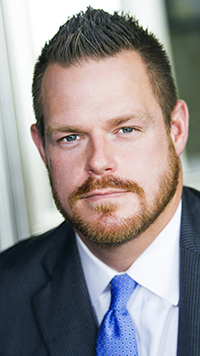National Geographic's 'Trafficked' looks at the most dangerous drug in America
Many of my columns in this series come from unexpected places. Recently, I was watching a sporting event when an advertisement for the new National Geographic channel series Trafficked aired. As is often the case, I paused the game, pulled up my viewing guide and clicked “record.” I wanted to save a few installments and see what the digital net might drag in.
After all, watching the series scroll across my screen perked my interest, if for no other reason than the title. I’m a criminal defense attorney. I handle lots of drug trafficking cases. That in and of itself was enough to create the necessary connection; however, I never knew how close to home one of the episodes would hit.
‘Trafficked’
National Geographic is no stranger to drug-related programming. The channel is home to Locked Up Abroad, one of my favorite long-running series in the general “crime” genre. Come to think of it, I’ve never covered that series for this column. That’s something I’ll have to revisit.
Regardless, Trafficked appeared to offer plenty on its own at first glance. The series covers a wide range of topics as it follows Mariana van Zeller while she travels the earth investigating “the complex and dangerous inner workings of the global underworld, black and informal markets.”
The topic itself is interesting enough, but it’s van Zeller—with her master’s degree from the Columbia University Graduate School of Journalism and a 2010 Peabody Award to her name—who adds enough humanity to ground the series in reality. Her award-winning work, coupled with the ace production so common to National Geographic’s offerings, seemed to be a perfect pairing.
Consequently, I knew that Trafficked would be well put together if nothing else, but I didn’t know if the show would provide any fodder for a column on law and pop culture. That is, until I saw the title of the series’ second episode: “Fentanyl.”
 Photo from Wikimedia Commons.
Photo from Wikimedia Commons.
Fentanyl: The ‘murder drug’
Trafficked does its best to relay the necessary PSA: Fentanyl will kill you, and the people manufacturing it do not care. The drug is a synthetic opioid created in Belgium in 1960 to aid in surgery and further treat the most severe forms of pain. The United States approved the drug for medical use in 1968.
Still, fentanyl’s prolific place among overdose-causing drugs didn’t gain worldwide attention until approximately five to six years ago, and its notorious reputation has continued to grow since. In 2017 alone, fentanyl and fentanyl analogs were credited with over 29,000 deaths.
Which brings up an interesting question: Outside of the medical context, should those who manufacture and/or dispense drugs be criminally liable for the death of the individuals who ingest the contraband?
In 1986, the federal government passed laws under the Anti-Drug Abuse Act of 1986 creating criminal liability, ranging from 20 years to life for defendants convicted of manufacturing or distributing controlled substances if death or serious bodily injury resulted from use of the underlying drugs. Over the next couple of decades, various other jurisdictions followed suit.
Accordingly, many states have similar laws on their books, and my home state of Oklahoma is one of them. Here in the heartland, an allegation of drug-induced homicide can quickly grow into a charge of first-degree murder, which in turn carries a mandatory minimum punishment of life in prison.
Even in states that don’t have specific laws related to drug-induced homicide, the same conduct can usually be charged as felony-murder or potentially a lesser degree of homicide, such as involuntary or even voluntary manslaughter.
Still, charging or refusing to charge individuals when a death occurs draws ire from everyone, depending on their position, as various voices fall on both sides of the debate. It’s understandable people would want to see the person who “killed” their loved one punished to the extreme. Conversely, there’s always the notion that when people play with fire, they very well may get burned.
The logic I return to analogizes the criminal drug-related activity with firearm manufacturing and sales. Should those who manufacture and sell firearms be responsible for the deaths those weapons cause? Sure, one can draw a distinction between the fact that the firearms in question are likely legally created and sold as opposed to the drugs. But remember—prescription drugs that would otherwise be legal cause a large proportion of overall overdoses.
Trafficked touts fentanyl as being “50 times more powerful than heroin,” and that sentiment seems to check out across the board. I couldn’t verify the quantitative comparison, but all of my research came to the same conclusion: Fentanyl is much, much more dangerous than other opioids. Many drugs, such as heroin, are now being supplemented with fentanyl to make the product more potent. In that context, my firearm analogy arguably falls apart when synthetic “home-cooked” or “cut” drugs are at issue.
Frequently, the inclusion of fentanyl is unbeknownst to the end-user and that use can cause their end as well. Perhaps this is the best place to draw the line: When a drug dealer or manufacturer knowingly alters the drugs they distribute to the degree they are exponentially more deadly, those individuals are crossing a line that even criminals should consider impermissible.
 Image from Shutterstock.com.
Image from Shutterstock.com.
True to life
Trafficked succeeds because it doesn’t merely look at contraband from a birds-eye view. Instead, it goes deep into the weeds to examine all aspects of the criminal enterprises it details. The episode I viewed took an in-depth approach to every facet of the fentanyl drug trade in Mexico’s cartel-controlled areas.
The audience was introduced to the method by which international cargo ships bring the necessary chemicals to Mexican ports from Asia and Europe. Viewers then witness interviews with everyone from the smugglers who get the chemicals, to the cooks who concoct the synthetic opioid, to the men who guard the stash houses where the product is kept. Even more compelling is van Zeller’s interactions and communication with the mules who bring the drugs into the United States and the people who then distribute the fentanyl across the country.
As I mentioned earlier, this episode had a personal connection for me and my law practice. Six years ago, a young man came to my firm seeking legal representation. He was a medical student who had become addicted to opioids, and he was in an awful place. He had been “caught” stealing medication from patients at the facility where he was working. His drug of choice was fentanyl.
At the time, I wasn’t very informed regarding the drug.
I knew it was used to treat pain. I had heard others mention “fentanyl patches” in passing, and I knew it was a powerful drug. Still, I had no idea how addictive it could be. At that time, we were acutely focused on the OxyContin epidemic, and even though fentanyl is an opioid as well, I never made the correlation.
Nevertheless, I knew it had to be extremely potent if it could take such a smart, driven and educated young man and turn him into an addict so desperate for a fix that he would steal medication from his own patients’ IV bags. Sadly, the young man died shortly after I represented him.
But another dead customer isn’t something drug dealers shed too many tears over. When one of the cartel cooks is confronted by van Zeller with the fact that fentanyl caused 30,000 deaths in the last year, he merely replies that they are aware, “but family comes first.”
With that perspective, the worst may be yet to come.

Adam Banner
Adam R. Banner is the founder and lead attorney of the Oklahoma Legal Group, a criminal defense law firm in Oklahoma City. His practice focuses solely on state and federal criminal defense. He represents the accused against allegations of sex crimes, violent crimes, drug crimes and white-collar crimes.
The study of law isn’t for everyone, yet its practice and procedure seems to permeate pop culture at an increasing rate. This column is about the intersection of law and pop culture in an attempt to separate the real from the ridiculous.



